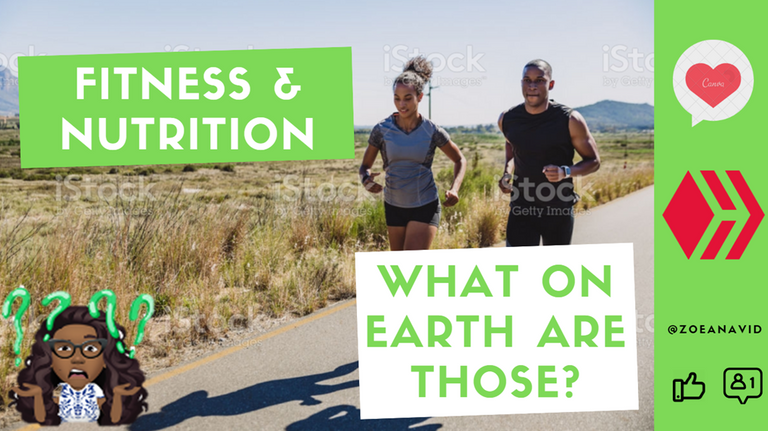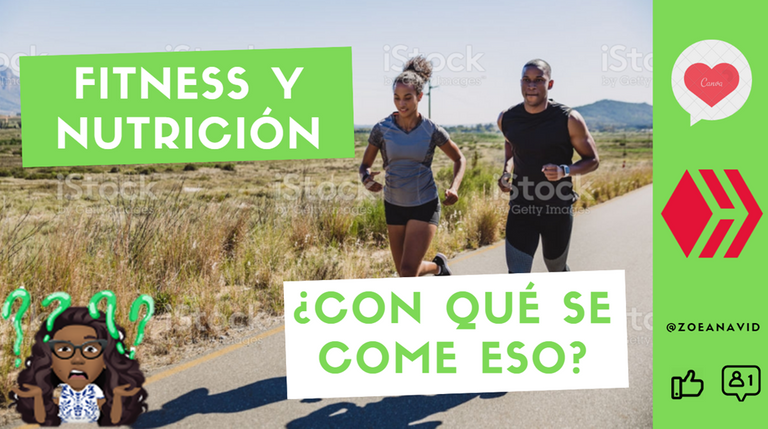
Image created on Canva.com by @zoeanavid
Hello dear readers, welcome! Let's talk about fitness and nutrition once again.
In the previous post, the first in this series on fitness and nutrition, I told you a little about my story and how my beginnings were in this business of being healthy. This path is not a stretch of a single day, we must bear in mind that we can mold and improve what we are on a daily basis, always with the desire to be the best version of ourselves. Life does not have to be short; on the contrary, it is in our hands to make our journey as beautiful and long as possible, to live with our loved ones and bequeath them a sustainable world.
As I have already mentioned, the main purpose of this series of blog posts is to share with you what I have learned in recent years and months, regarding the healthiest practices in the universe of fitness and nutrition. The topic of today's publication may be a bit theoretical since in order to begin to deconstruct those deeply rooted myths it is important to return to the most basic thing: concepts. So, let's get to work!

📷 © @zoeanavid, 2015
Fitness, what is it?
Misconceptions and definitions of the term
Both social networks and the media have generated decades and decades of misinformation about what "fitness" means. For many, it represents the image of every person who engages in excessive exercise and who limits themselves with dieting. A rather extreme perspective, in my opinion. This has resulted in the majority of people looking for shortcuts, that is, how to get the best body as fast as possible and with the least possible effort. Thus, numerous myths have been generated and continue to be shared massively.
In this article in the Huffington Post, in response to a question from Quora, they agree that fitness involves exercise and good nutrition, but they give a somewhat vague and overly broad idea. To understand what "being fitness" is in today's society, let's better refer to science and draw our own conclusions.

📷
Throughout the development of the sports and health sciences, various definitions of the term fitness have been coined. Below, I list some of them to put us in context, first a biological definition and then a sports definition:
- In biology, Sober (2001) tells us that "fitness", or physical fitness, is used to describe the degree to which organisms "fit" in their environment and can adapt to it. The success of an organism in avoiding predators and being able to build a nest obviously contributes to its physical state or fitness, and that of its offspring.
- In sports, Malina (2010) suggests that “fitness”, or physical state, is the ability of a person to perform physical activity that requires a certain resistance, strength, or flexibility, and that is determined by a combination of regular training and genetic factors.
Taking into account what has been raised by the different authors, I propose here a definition that in my opinion is quite accurate and broad, due to its applicability to numerous scales and areas:
So how do you improve your fitness? It comes down to this: exposing your body to an adaptive stimulus, through regular physical activity, progressively increasing intensity, exercise volume, or both. However, physical activity is only one of the elements necessary to develop an optimal state of health. Another very important factor, which we will talk about next, is nutrition.

Image creada en Canva.com por @zoeanavid
Nutrition, what is it?
Some myths and truths
According to the World Health Organization (WHO), "health is a state of complete physical, mental and social well-being, and not just the absence of disease or illness." In this sense, eating well implies more than just consuming food. A healthy diet can be defined as that which provides each individual with all the food necessary to cover their nutritional needs, which depend on factors such as age, sex, level of physical activity and state of health.
Adequate nutrition must be complete, providing all the necessary nutrients for life (carbohydrates, proteins, fats, vitamins, minerals, and water). On the other hand, it must also be varied, containing elements from various food groups (dairy, fruit, vegetables, cereals, legumes, meats and poultry, fish, etc.). In addition, it must be kept within the daily caloric needs of each one, depending on age, sex, and physical activity.
Unlike the restrictive diets that have become fashionable on social networks (intermittent fasting, keto, paleo, carnivore, etc.), a varied and complete diet will be pleasant and sustainable over time, and will also more safely guarantee a sufficient intake of macro and micronutrients. Myths like "eating fat makes you fat", "eating bread makes you fat", "eating fruit makes you fat", "the more protein the better", etc., are being progressively dismissed by the growing science that is nutrition, because what really matters, regarding fat loss and increased muscle mass, is the energy balance: calories in, calories out.
In later publications, we will talk about the cardiovascular activity as a fundamental exercise to prolong and improve quality of life, as well as some nutritional tips to consume enough calories a day, improve health and be able to lose fat and/or increase muscle mass, according to the objectives of each one.
I hope you enjoyed this conversation about fitness and nutrition! 😄 Any questions, comments, or suggestions, see you in the section below ✅ Until next time!
Sources:
- Huffington Post. (2018). What are the misconceptions about fitness?. Available online [here] (https://www.huffingtonpost.es/quora/cuales-son-los-conceptos-erroneos-sobre-el-fitness_a_23502177/).
- Sober, E. (2001). The two faces of fitness. In R. Singh, D. Paul, C. Krimbas, and J. Beatty (Eds.) Thinking about evolution: historical, philosophical, and political perspectives. Cambridge University Press, pgs. 309-321.
- Malina, R (2010). Physical activity and health of youth. Constanta: Annals of Ovidius University, Physical Education and Sports/Science, Movement, and Health Series.
- World Health Organization. (2020). Frequently asked questions. Available online [here] (https://www.who.int/en/about/who-we-are/frequently-asked-questions).
Disclaimer: The text of this publication is the product of my personal opinions, based on my research on the subject. It is in no way a substitute for the advice of your personal physician.


Image creada en Canva.com por @zoeanavid
¡Hola, queridos lectores, bienvenidos! Hablemos una vez más sobre fitness y nutrición.
En la publicación previa, la primera de esta serie acerca de fitness y nutrición, les conté un poco de mi historia y cómo fueron mis inicios en este negocio que es ser saludable. Este camino no es trecho de un solo día, hay que tener presente que diariamente podemos ir moldeando y mejorando lo que somos, siempre con la voluntad de ser la mejor versión de uno mismo. La vida no tiene por qué ser corta; al contrario, está en nuestras manos hacer de nuestro transitar el más hermoso y largo posible, para convivir con nuestros seres queridos y legarles un mundo sostenible.
Como ya les he mencionado, la finalidad principal de esta serie de entradas en mi blog es compartir con ustedes lo que he aprendido en los últimos años y meses, respecto a las prácticas más saludables del universo del fitness y la nutrición. El tema de la publicación de hoy quizás les resulte un poco teórico, ya que para poder empezar a deconstruir esos mitos tan arraigados es importante volver a lo más básico: los conceptos. Así que, ¡manos a la obra!

📷 © @zoeanavid, 2015
Fitness, ¿qué es?
Conceptos erróneos y definiciones del término
Tanto las redes sociales como los medios de comunicación han generado décadas y décadas de desinformación respecto a lo que significa el "fitness". Para muchos, representa la imagen de toda persona que se dedique al ejercicio excesivo y que se limite a hacer dieta. Una perspectiva bastante extremista, en mi opinión. Esto ha derivado en que la mayoría busque atajos, es decir, cómo obtener el mejor cuerpo lo más rápido posible y con el menor esfuerzo posible. Así, numerosos mitos se han generado y se siguen compartiendo masivamente.
En este artículo del Huffington Post, como respuesta a una pregunta de Quora, coinciden en que fitness involucra ejercicio y buena alimentación, pero dan una idea un tanto vaga y demasiado amplia. Para entender qué es "ser fitness" en la sociedad actual, mejor remitámonos a la ciencia y saquemos nuestras propias conclusiones.

📷
A lo largo del desarrollo de las ciencias de la salud y el deporte, se han acuñado diversas definiciones del término fitness. A continuación, listo algunas de ellas para ponernos en contexto, primero una definición biológica y luego una definición deportiva:
- En biología, Sober (2001) nos dice que el “fitness”, o la aptitud física, se utiliza para describir el grado en que los organismos "encajan" en su entorno y pueden adaptarse a este. El éxito de un organismo al evitar a los depredadores y poder construir un nido obviamente contribuye a su estado físico o fitness, y al de su descendencia.
- En el deporte, Malina (2010) nos plantea que el “fitness”, o el estado físico, es la habilidad que tiene una persona para realizar actividad física que requiera de cierta resistencia, fuerza o flexibilidad, y que está determinada por una combinación de entrenamiento regular y factores genéticos.
Teniendo en cuenta lo planteado por los diferentes autores, propongo aquí una definición que en mi opinión es bastante acertada y amplia, por su aplicabilidad a numerosas escalas y ámbitos:
Entonces, ¿cómo mejorar tu fitness? Se resume en esto: exponer tu cuerpo a un estímulo adaptativo, mediante la actividad física regular, aumentando progresivamente la intensidad, el volumen de ejercicio, o ambos. Sin embargo, la actividad física es solo uno de los elementos necesarios para desarrollar un estado óptimo de salud. Otro factor importantísimo, del cual hablaremos a continuación, es la nutrición.

Image creada en Canva.com por @zoeanavid
Nutrición, ¿qué es?
Algunos mitos y verdades
Según la Organización Mundial de la Salud (OMS), «la salud es un estado de completo bienestar físico, mental y social, y no solamente la ausencia de afecciones o enfermedades». En este sentido, alimentarse bien implica más que solamente consumir alimentos. Una alimentación saludable puede definirse como aquella que aporta a cada individuo todos los alimentos necesarios para cubrir sus necesidades nutricionales, las cuales dependen de factores como la edad, el sexo, el nivel de actividad física y el estado de salud.
Una nutrición adecuada debe ser completa, aportando todos los nutrientes necesarios para la vida (carbohidratos, proteínas, grasas, vitaminas, minerales y agua). Por otro lado, también debe ser variada, conteniendo elementos de diversos grupos alimenticios (lácteos, frutas, verduras y hortalizas, cereales, legumbres, carnes y aves, pescados, etc.). Además, debe mantenerse dentro de las necesidades calóricas diarias de cada uno, dependiendo de la edad, sexo y actividad física.
A diferencia de las restrictivas dietas que se han puesto de moda en las redes sociales (ayuno intermitente, keto, paleo, carnívora, etc.), una alimentación variada y completa resultará agradable y sostenible en el tiempo, y además garantizará con mayor seguridad una ingesta suficiente de macro y micronutrientes. Mitos como "comer grasa engorda", "comer pan engorda", "comer frutas engorda", "mientras más proteína mejor", etc., están siendo progresivamente descartados por la ciencia en crecimiento que es la nutrición, porque lo que realmente importa, respecto a la pérdida de grasa y el aumento de masa muscular, es el balance energético: calorías ingeridas, calorías gastadas.
En publicaciones posteriores, conversaremos acerca de la actividad cardiovascular como ejercicio fundamental para prolongar y mejorar la calidad de vida, así como de algunos tips nutricionales para consumir suficientes calorías en el día, mejorar el estado de salud y poder perder grasa y/o aumentar la masa muscular, según los objetivos de cada uno.
¡Espero que hayan disfrutado esta conversación acerca del fitness y la nutrición! 😄 Cualquier duda, comentario o sugerencia, los veo en la sección de abajo ✅ ¡Hasta la próxima!
Fuentes:
- Huffington Post. (2018). ¿Cuáles son los conceptos erróneos sobre el fitness?. Disponible en línea aquí.
- Sober, E. (2001). Las dos caras de la aptitud. En R. Singh, D. Paul, C. Krimbas y J. Beatty (Eds.) Pensando en la evolución: perspectivas históricas, filosóficas y políticas. Cambridge University Press, págs. 309-321.
- Malina, R (2010). Actividad física y salud de la juventud. Constanta: Anales de la Universidad de Ovidius, Serie Educación física y deporte/ciencia, movimiento y salud.
- Organización Mundial de la Salud. (2020). Preguntas más frecuentes. Disponible en línea aquí.
Exoneración de responsabilidad: el texto de esta publicación es producto de mis opiniones personales, basadas en las investigaciones que realicé sobre el tema. De ningún modo sustituye el consejo de tu médico personal.


